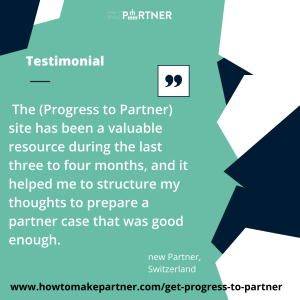‘That’s just too hard!’, ‘I don’t know where to start!’, ‘How to find the time for business development?’, ‘…but I’m a good technician…I don’t need to win new businesses’. Sound familiar?
Quite frankly, the biggest thing that holds so many great lawyers, accountants, and consultants from progressing their career is knowing how to find the time for business development. So much so that I regularly write, speak and train specifically on this one topic.
Having successful business development habits that help you consistently grow your client portfolio is key if you’re wanting to move from senior director, senior manager/associate positions to partner. Nevertheless, many lawyers, accountants, and consultants are reluctant business developers.
And I would say their number 1 objection is (I’m sure you’ll guess this one): “I don’t have time for this”. It’s all good with having a clearer idea of how to create a strong LinkedIn profile or how to create content that helps you win new work. But how do you actually make time to grow your client portfolio?
In this article, I tell you exactly how to make time and headspace for business development. By the way, this article comes from a fragment of my Progress To Partner Academy Virtual Masterclass “How to win work in only 30 minutes without leaving your house”.
Take a step forward to be in control of your own career progression in your firm. Sign up to my weekly tips here and you’ll find out what you need to be working on in your career development (and how to make the time for your career development) to progress your career in your firm.
Need a little helping planning your business development and marketing efforts? Click here to download my FREE Guide to Creating your Marketing Plan.
The 5 Ps you need to keep in mind to create time for business development
1) Hone in on your PLAN
No matter who you are reaching out to, you always want to have an action plan before you randomly start contacting people on LinkedIn or attending virtual events. If you come to think of it, you need as much as a plan as you’d need one before attending an in-person networking event. And your activity and efforts at connecting on LinkedIn are truly the same as attending an in-person networking event.
So many people are now working remotely, making this the perfect time to expand your virtual connections; treating them exactly as you would an in-person event. So, with that mindset, you need to ask yourself, ‘What am I going to do and how am I going to do it?’ and, even more importantly, ask yourself, ‘What should I truly be doing on a day to day basis?’ That is the level of planning that will lead you ultimately to results. If you don’t make a daily effort, then your plan becomes a wishlist, and that’s not what we want.
 I created the Progress to Partner online Academy to make this as easy as possible. There are guides, 14 self-study courses, useful videos and recordings and workbooks waiting for you – everything you need to know about how to make partner all in one place! There’s even a course on “how to make the time for business development”. Join Progress to Partner Academy here
I created the Progress to Partner online Academy to make this as easy as possible. There are guides, 14 self-study courses, useful videos and recordings and workbooks waiting for you – everything you need to know about how to make partner all in one place! There’s even a course on “how to make the time for business development”. Join Progress to Partner Academy here
Need a little helping planning your business development and marketing efforts? Click here to download my FREE Guide to Creating your Marketing Plan.
2) Have a clear PROSPECT LIST
Once you have a clear idea of who you want to get in touch with, it becomes so much easier to hone in on your prospect list. This list can be one large list, or it can be broken up into different categories, such as prospect lists, introducer lists, etc. Regardless of how you decide to restructure your prospect list, remember that actually understanding your niche is what’s key here.
So, if you aren’t clear yet about who you are speaking to, Join Progress To Partner Academy and go straight to Module 1 of How to become the Go-To Expert self-study course. You need that desk-based research completed first. Otherwise, you are dancing in the dark.
3) PRIORITISE, prioritise, prioritise
It’s all good with having a business development plan, but how do we accomplish it? Well, it all comes down to prioritising the right way. And part of prioritising the right way has to do with not pushing for doing too much but instead objectively planning for the time that you do have available.
We only have a certain amount of time each day, which is why it’s so important to ask yourself ‘if I only have time for one thing today, 30 minutes, what is it?’
So, you look at your 30 minutes and you decide what the most important thing is, and how you’re going to accomplish it. But, how do you prioritise? What do you do within those 30 minutes?
Here is where you think, ‘If I’m going through my messages on LinkedIn takes me 5-10 minutes, then what do I allocate the next 20 to?’
There’s no golden rule on what sort of activities should be prioritised over others, as this will depend on the list of business development efforts you are considering, the time each of them would take you, and the outcome you can expect from them.
Don’t miss the great course in Progress to Partner Academy called How to Make time for Business Development. The course gives you the structure, clarity, and guidance to create a daily business development habit and a business development plan that is focussed and not just based on friendly coffees! Join Progress to Partner Academy here
However, as a general rule of thumb, you should focus on what is going to produce the best results for the least amount of effort from you.
4) PACE yourself
One of the reasons why lawyers, accountants and experts in the professions are SO reluctant to do business development is that they think they need to do everything at once. Let me state this clearly: this is not true. You don’t need to join all the professional networks AND send 100 Linkedin connection requests AND run three webinars in a month AND write 3 blog articles.
Actually, you don’t even need to allocate 30 minutes a day every day to business development. You need to pace yourself and create a plan that works for YOU! For instance, you could break up your week a little differently, and you allocate an hour to a project that has a short deadline, and then instead spend 10 minutes per day on LinkedIn instead of half an hour.
 There’s another great course in Progress to Partner Academy called “How to Truly Commit to Moving your Career Forward”. It really is a game-changer and will get you focussed and help you to create the time and space to work a little on your career plan every.single.week.
There’s another great course in Progress to Partner Academy called “How to Truly Commit to Moving your Career Forward”. It really is a game-changer and will get you focussed and help you to create the time and space to work a little on your career plan every.single.week.
Remember, Rome wasn’t built in a day, and just like Rome, you need a plan that you will be able to consistently stick to in order to succeed.
5) PUSH DOWN work to your team
Let’s face it. No matter how much of a great technician you are, you won’t make it to partner if you don’t have a support team that you can rely on. One of the biggest changes that you can make, that will take you from a director role, or senior manager, to partner, includes pushing down the technical stuff.
This can be easier said than done. It might be because you have an upwards delegation issue with your team, or simply because you just enjoy doing that highly technical stuff. Regardless of your own personal reasons, working on this is absolutely key. Pushing down work to your team will then free you up and give you more time to focus on what will help you move forward with your previously defined priorities. Need a little helping planning your business development and marketing efforts? Click here to download my FREE Guide to Creating your Marketing Plan.
Turning your business development actions into sustainable habits.
Although we may know that daily business development efforts need to happen, it can be easier said than done. And the reality is, if you want your spare business development tasks to become recurrent and consistent, you need to turn them into embedded habits. I will use myself as an example. I go onto LinkedIn every single day. It’s a habit. I don’t have to think about it. I
have an unwritten rule in my head that a good day is a day that I get an update on LinkedIn, ideally before half past seven, but definitely before 9:00 AM. I don’t need to think about whether I will or I won’t, I just aim to do it daily, and by doing so, I have created a habit. This habit does not necessarily have to apply to your LinkedIn activity either. This can be applied to your content creation, article writing, whatever it may be, and by making it an automatic habit, it brings you one step further on your path.
Care to know why this works? Well, basically our brains can only make a certain amount of decisions each day. Because of this, we often go into ‘autopilot’ where we fall back into our old ways, routines, and habits. That is why making a conscious decision, every day, to change our behaviour and habits in order to help benefit ourselves, and to reach the end goal of our plan, is so important.
Honestly, if you’ve got a plan, you don’t even have to consciously think about what business development you’re going to work on, because it’s on today’s to do list! And that truly is one of the ways that we can make our business development so much easier. By making these changes sustainable habits, we then make our business development a daily normality. If you want to start working on replacing old habits with new ones, you need to identify:
- The trigger for the old habit you want to change
- Any activities you’d need to stop.
- The new activities you want to start doing
- And the reward you are going to get for doing them.
Take a step forward to be in control of your own career progression in your firm. Sign up to my weekly tips here and you’ll find out what you need to be working on in your career development (and how to make the time for your career development) to progress your career in your firm.
How do we create a long lasting habit?
When we aim to create a long lasting habit, we want to be sure to make it part of our routine, and to also make it simple. For instance, you can plan on doing three particular things a day, or even two particular things a day. By making them part of your business development routine, you’re establishing yourself and your plan. An easy way to remind yourself of these tasks, is using a tick list. By creating one, you’re making yourself accountable, but also rewarding yourself once your task has been completed. Need a little helping planning your business development and marketing efforts? Click here to download my FREE Guide to Creating your Marketing Plan.
I created Progress to Partner Academy to make this as easy for you as possible. There are guides, self-study courses, useful videos, workbooks waiting for you – everything you need to know about how to make partner in your professional services firm all in one place. Join Progress to Partner Academy here
Think of new triggers and rewards to your soon-to-established new habits
Another benefit to the creation of habits is they stop the voice of doubt or fear from getting in the way, which truly can be half the battle for a lot of us! And when we are creating habits, it’s important to set a trigger to remind us to do something. For instance, I sit down at the breakfast bar in my kitchen, and I want to write my LinkedIn update for the day. That’s my trigger. What can be your trigger? When commuting was a regular thing for most people, that time would be part of their trigger to go onto LinkedIn.
Sadly, we don’t often don’t have that commute now, or it’s less common. So, because of this change in lifestyle, you have to determine what your new trigger can be. Maybe it can be when you switch on your machine. You just go straight to updating your LinkedIn, and then make yourself your first cup of coffee of the day. That positive stimulus needs to present.
Create a reward for yourself that you look forward to, and from there, your brain will start to associate the habit as a positive. So, the next time that you complete the task that you’re choosing to make a priority, your brain will automatically associate the habit with a positive occurrence. If you know your why, or know the actions that you truly enjoy, you’ll feel rewarded, which then helps lead to the formation of a habit.
Take a step forward to be in control of your own career progression in your firm. Sign up to my weekly tips here and you’ll find out what you need to be working on in your career development (and how to make the time for your career development) to progress your career in your firm.
Replace your current habit with a new habit
Now, whether we like it or not, when we form a habit, it means we have to replace an existing habit with a new habit. You currently may have the habit to work on everything but your business development. And, once you identify exactly what that habit is, you have to seek to change it.
What can be helpful is making sure that it’s the first thing that you do every day. Right now, the first thing that you probably do is switch on your machine, look at your email, and start to answer the stuff that comes in from clients and partners. Already, your habit isn’t to focus on developing your own business, but to handle those technical tasks that we mentioned earlier. And this is something that has to change if you want to see results. Remember, it’s all about prioritising correctly. Whatever you write at the top of your daily tasks is what you’d spend most of your time (and attention) doing.
Start working on long-lasting business development habits now!
Although it may seem as though designating 30 minutes a day to business development efforts can be impossible, it’s easier than you think. When you have your end goals in the back of your mind, you’ll be able to plan ahead, create daily business development habits that stick, and actually start winning work. Now that we know how to retrain our minds to associate our new habits with a positive reward, we have to make them long term and long lasting habits. In order to do this, these habits must be made a priority, worked on every single day, until it becomes a lasting habit. For this to be successful, do what works best for you! Need a little helping planning your business development and marketing efforts? Click here to download my FREE Guide to Creating your Marketing Plan.
Not everyone is the same. For some, it’s about accountability, for others it can be writing the habit down and following through with it. It may seem like a lengthy process, but you will adapt quicker than you think and will ultimately rewire your brain to think ‘What else can I simplify? If I do this, that means I do this, this and this, all I have to do is focus on this and monitor it.’
 Don’t worry about trying to do too much at once. Find what works and sticks for you, reward yourself to create those daily habits, and make it a personal, daily goal to work towards your business development every single day. I promise, you will start seeing the results sooner than you can expect! Want to learn more about how to become the person people go to when they have work you want? Make sure you sign up to Progress to Partner and get started on the self-study courses that will show you how to network, win work and get noticed ahead of your peers as “one to watch”
Don’t worry about trying to do too much at once. Find what works and sticks for you, reward yourself to create those daily habits, and make it a personal, daily goal to work towards your business development every single day. I promise, you will start seeing the results sooner than you can expect! Want to learn more about how to become the person people go to when they have work you want? Make sure you sign up to Progress to Partner and get started on the self-study courses that will show you how to network, win work and get noticed ahead of your peers as “one to watch”








